Are all pianos basically the same?
One thing that can be confusing as piano buyer’s guide themselves through researching instruments is the salesmen’s hype about where a piano is built. The funny thing is that, when most people start their research, they don’t really care where a piano is made when they compare pianos. It’s the salespeople – and salespeople posting as bloggers – who try to make it sound like something customers should worry about. They want you to believe that every piano built in a particular factory is exactly the same and that it’s your lucky day because they sell the one.

“Hey, have I got a deal for you!”
It is easy to compare how well built a piano is – regardless of where it’s built. Armed with this information, you can find a better piano in your budget and potentially save you thousands of dollars in repairs down the road.
Let’s Compare Pianos from the Same Factory
For this piano review, we’re going to focus on lower price options as we compare two instruments built by Pearl River. Pearl River is one of the world’s largest piano producers making countless brands for just as may distributors. They range in quality, but just because they build some low-end pianos doesn’t mean every piano they build is low-end. Here is a great example.
Piano Buyer’s Guide
Ritmüller pianos are built by Pearl River for Pearl River – they own the brand. Essex pianos are built by Pearl River, but Essex models are designed – and the brand is owned – by Steinway & Sons. They come out of the same factory – but – are they the same piano? Let’s take a closer look.
Soundboard
Spruce is the most common wood used in piano soundboards because it is a strong softwood with continuous parallel grain. These straight lines move sound waves like water in a canal, efficiently spreading the energy along the board. Because the spruce is a premium material, it is a great visual indicator of how well built a piano is. Because the spruce is a premium material, it is a great visual indicator of how well built a piano is.
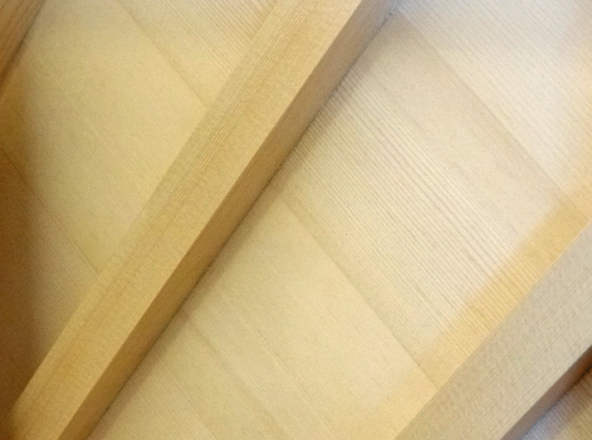
Straight, tight grain and honey color are signs of quality spruce in the Essex piano soundboard.
While most grand pianos will use some variety of spruce, upright pianos can hide some big secrets in their little cases. If you compare the Essex soundboard, it looks on par with a really nice grand piano, with consistent tight grain and color that are characteristic of spruce.
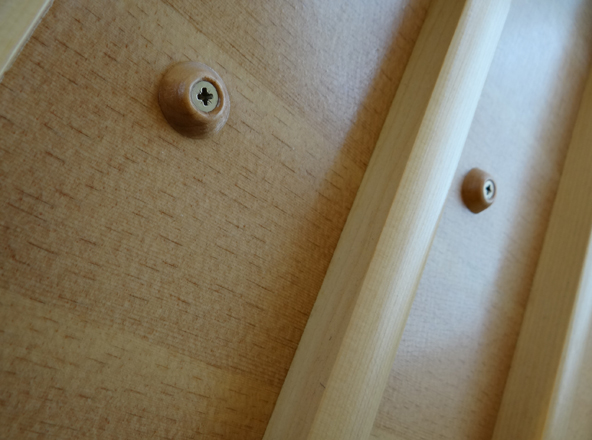
The broken grain in the Ritmuller soundboard is a sure sign that it is not spruce.
A quick look at this Ritmuller piano reveals something odd. Notice the broken, darker lines compared to Essex soundboard? That’s because the Ritmüller did not use spruce. Based on the grain pattern, this looks like agathis – a cheaper wood found only in the Southern Hemisphere and usually used in toy musical instruments like children’s guitars.
Looking closer the Essex spruce soundboard, we notice that it is tonally shaped – like a grand piano.
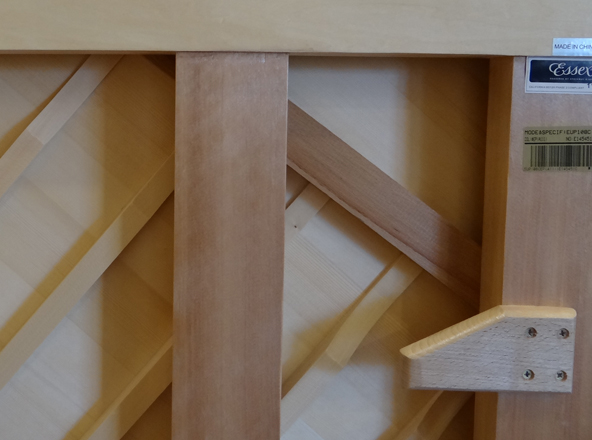
That simple block of wood running at a 45 degree angle tonally shapes the soundboard. This simple addition prevents overtones and focuses the sound.
Steinway designed pianos use a block of wood to shape the speaking area of the board, deadening the part that would create overtones, resulting in clear, pleasant high tones.
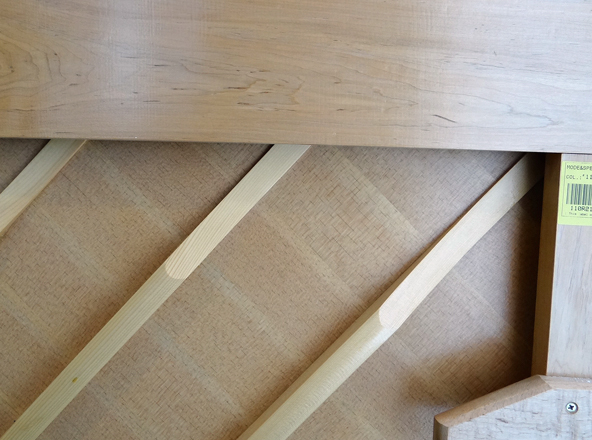
The Ritmuller piano doesn’t use tonal shaping.
Notice the missing block of wood (which costs about fifty cents) that means the soundboard is not tonally shaped.
Plate Gap
For a soundboard to work efficiently in any acoustic instrument, it needs to move freely. Anything that restricts the vibration of the board takes away some of the sound. That’s why good quality pianos always “float” the plate – which can weight 300 pounds or more – by anchoring it to the frame while keeping it from contacting the soft soundboard.
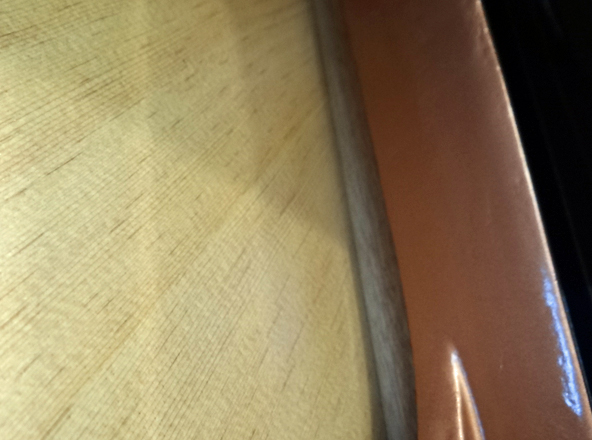
A block of wood is clearly visible sandwiched between the heavy iron plate and the soundboard.
This gap – or lack of gap – is really easy to see in an upright piano. Looking at the inside of the Ritmüller piano reveals the plate and a wood strip screwed into the soundboard. This screw goes through to the back of the piano and into another strip of wood, sandwiching and compressing the soundboard.
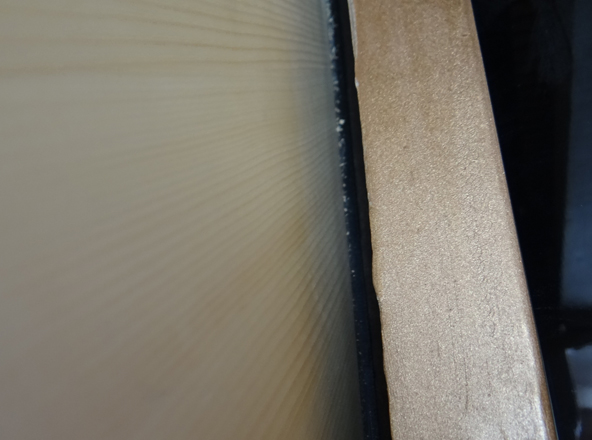
The gap between the 300 pound iron plate and spruce soundboard in the Essex piano allow the tapered board to vibrate freely. This is one reason why Essex pianos sound more clear and full than other pianos in their price range.
Looking at the same spot on the Steinway Essex piano reveals the frame! The plate and board do their jobs independently of each other – and they both do it very well – in the Essex! It takes a little longer to build a piano this way, but the result is a piano that gives you all of the sound you paid for.
Frame and Bracing
The difference in bracing between these pianos is another example of how different pianos from the same factory can be. The Essex sturdy frame and backposts are clearly visible on the Steinway designed piano. They’re harder to see on the Ritmuller piano by Pearl River because, well, they’re not there.
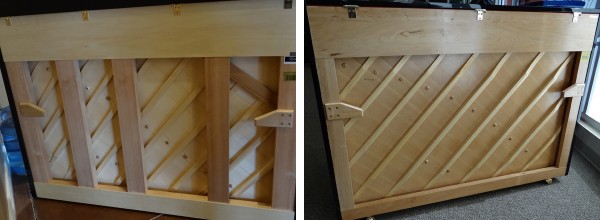
The backposts and thicker frame on the Essex piano (left) compared to the Ritmuller piano (right) with a thin frame and no backposts to reinforce the plate.
This is really important because – along with the plate – the frame helps the piano keep its shape under the extreme tension created by the strings being pulled into tune. Over the years, this tension can twist a piano from the inside. The shift of even a few millimeters can pull parts of the piano apart and make it untunable.
All that we are looking at here is the backs of the pianos and the difference is striking.
Bass Bridge
Bass bridges are easy to see on upright and grand pianos. On an upright, simply remove the bottom board and the bridge will be front and center. The shape of the bridge will tell you as much about the builder’s “attitude” toward building as the soundboard will tell you about the quality of construction.
Determining the “speaking length” of each of the 200+ strings in a piano is a science that’s best left to piano scale designers, but simply put, there is a sweet spot where each string should contact the bridge to bring the best sound into the soundboard. Unfortunately, the gods of piano design refuse to make it as easy as drawing a straight line. That’s why every piano that is designed to offer great sound possible will have a curved bass bridge. The curve is strategic and insures that the sweet spot lands on the bridge.
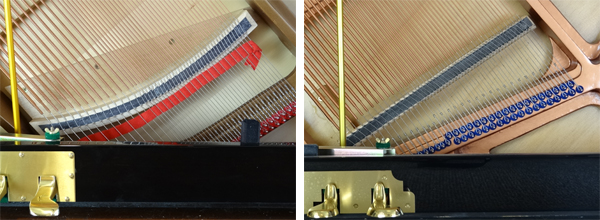
The Essex piano on the left has a bass bridge that is designed to contact the sweet spot of each string. The Ritmuller piano on the right has a straight bridge, resulting in muddy, undefined low notes.
Now it gets really easy. You can easily see that the Essex bridge is curved – like all Steinway designed pianos – while the Ritmuller bridge is straight. Straight bridges are easier to make. Curved bridges sound better.
Side-by-side, you will notice a big difference. Playing the notes below middle C all the way to the left and you’ll notice a more full, rich tone on a piano with a curved bridge. Pianos with straight bridges sound more hollow or thumpy as the notes get lower. While many salespeople will attribute the sound to being “just how uprights are,” it is really because the builder decided to cut corners.
Action Parts
Both of these pianos have wood action parts. High quality wood offers remarkable durability in a piano’s action and – when done right – a responsive feel that just can’t be replicated with plastic. As we discussed in the section about soundboards, not all wood is created equal.
If you’re going to build a good piano, it’s important to be fussy about the wood. This means selecting material for each piano that is consistent throughout that part. Notice how the color and grain is similar in all of the pieces of the Steinway Essex piano action.
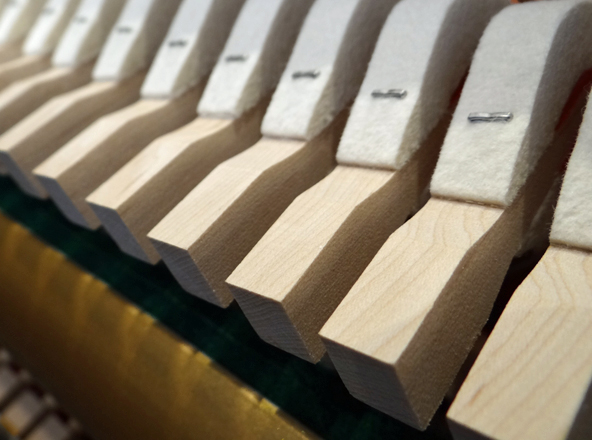
Grain orientation is consistent – as is color – in the Essex piano action.
In the Ritmuller piano, sometimes you see the grain of the wood and sometimes you see – well – spots.
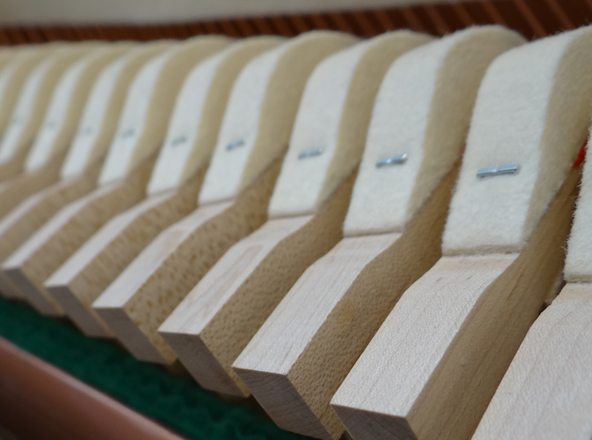
Pearl River Ritmuller piano action.
Those spots tell us that, while the wood is likely the same variety and quality as the other parts, they were trying to get more wood out of the log so they had to cut pieces at different angles. Where you see spots, you’re seeing the same type of wood, but at a 90 degree angle. Since grain gives wood its strength, consistent grain is critical for consistent performance… even if it means finding another use for the scraps.
Extruded Aluminum Action Rail
Even piano builders who use plastic in their piano actions concede that it is important to mount these thousands of small parts on a sturdy base. Slight shifts in the alignment of the action parts is like shining a flashlight on something 20 feet away. Moving the flashlight just a fraction of an inch will cause the light to miss the target.
In the early days of the piano – we’re talking 300 years ago – the only real choice was to use a wood rail. Even though they new that that wood would bend, swell, warp, or crack enough to permanently change how the piano played, pianos were only expected to last for a few years. The technology changed so quickly that the piano was kind of like the Blu-ray player of the eighteenth century – something better was going to come out in a few years. How long the action rail would last was like being concerned with the lifespan of a remote control’s batteries.
As the piano became more and more perfected, they needed a better action rail. Steinway & Sons invented a remarkable system using a maple dowel pressed into a brass tube that is remarkably stable and effective – even outlasting the action parts most of the time – that they still use today. The quest was to find something that could be stable for the life of an average modern piano that was also cost effective.
1894 brought us extruded aluminum – thank you Alexander Dick! The decades that followed gave us rails made from extruded aluminum (it’s fun to say out loud) were strong and rigid, yet the metal was soft enough to screw into. Ridges and lines were added to lock components into place. And with a melting point of 1,221 Fahrenheit, changes in temperature or humidity leave it unchanged.
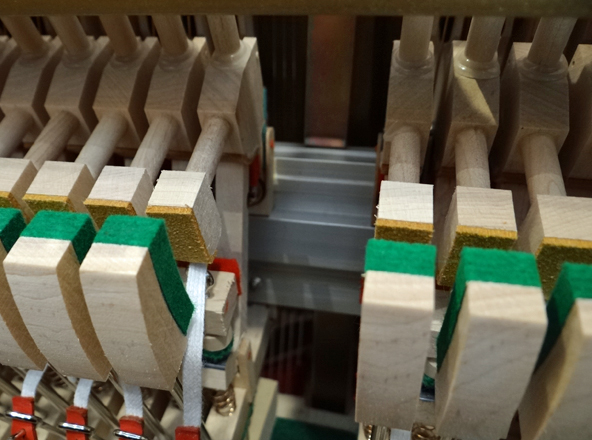
The aluminum action rail can be easily seen in the natural gaps between action parts in the Essex piano.
Today, this technology is usually common in this price range. Still, a quick look reveals that the Steinway Essex piano has an extruded aluminum action rail. The Ritmuller (did we mention it was built in the same factory?) has a rail made out of… wood.
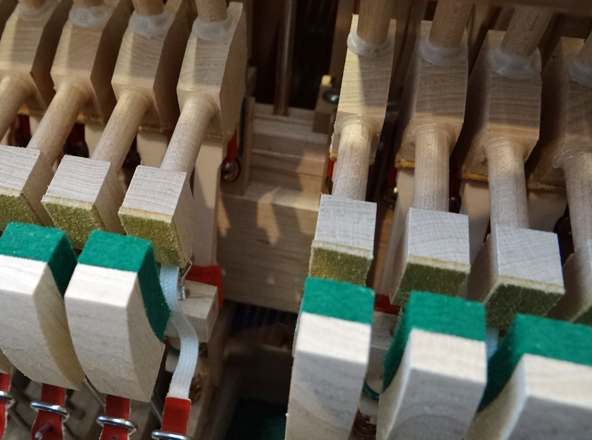
Wood action rail in the Ritmuller piano.
Does It Matter Where a Piano is Built?
Although they may be built in the same factory, the Pearl River Ritmuller piano and the Steinway designed Essex piano are very different. You will find many of the same difference between better quality pianos like the Essex and new and used Yamaha pianos built in China and Japan, new and used Kawai pianos built in Japan and Indonesia, and Eastern European brands like Petrof, Estonia, and Bohemia. Essex pianos incorporate many of the patents that have made Steinway & Sons the world’s favorite. Others brands may look the same on the outside, be built in the same factory or the same country, but they are very different on the inside.
It is fair to say that, not only is the Essex piano far better based on the design and the materials used, the upright model is it built more like a Steinway grand piano that a lower priced upright.
Note that we didn’t need any tools for our comparisons. Every piece of the piano that we removed for the purpose of this review is designed to come off – as easy as taking the leaf out of a dining table. Everything we looked at can be seen with the naked eye. That means you can easily get an idea of a piano’s quality whether in somebody’s house or a piano showroom.
And the next time a salesperson tries to tell you that a piano is better or worse because of where it’s built, you’ll know to head for the door and find an expert who understands the difference between where it came from and how it’s made.
* According to the Ritmuller piano website, they list some of their pianos as having “all spruce,” “solid spruce,” or nothing listed for their soundboards. As of the publication of this piano review, they do not reveal the wood used for all of their piano model’s soundboards. All spruce soundboards are laminated boards that use a thicker core of lower quality wood with a tighter grain veneer on either side, making the board look like higher quality wood than they actual are. Solid spruce boards are a solid piece of wood for the entire thickness meaning the quality of the wood is consistent throughout the board.
* Essex piano soundboards are high quality solid spruce – comparable to the best pianos built in Japan and most high priced European pianos – with the added benefit of a taper. This is similar to how a Steinway soundboard is made. Tapered boards are always higher quality boards and are never laminated.
These comparisons are based on physics and accepted practices in piano design. Most companies who use lower quality materials and building techniques will also build a better version – but at a higher price. Any competent piano technician will agree with our opinions.
Your Ritmuller information is GREAT! Thanks for sharing.
Good info. You definitely get more with an Essex.
great info! i´ll be very happy with my new essex up 123!
You clearly show a “Ritmuller” with no back posts. You are probably showing a Pearl River, not a Ritmuller.
Thanks for visiting our site, Richard. The photos are, in fact, of a Ritmuller piano. It can be very difficult to tell the difference between these and the Pearl River branded models. Looking closely at the pictures here and then comparing them when you’re shopping in a store should help a lot!
When in doubt, focus on the designer of the piano and the company standing behind the product. It’s nice that Steinway offers the Essex for people looking for a higher quality instrument in a lower price range from a company they can trust.
Good luck with your shopping!
… Pearl River first acquired the Ritmuller brand, they put out a handful of old Pearl River designed pianos, with the Rit name on it…
Comment filtered because it came from a piano dealership
Thank you for visiting and for the kind words about the website and this blog.
Wow, what great information!
I own a Ritmuller and really wish I’d read this article first. It’s too late for me, but be sure to check out Steinway’s Essex pianos. Great value for the money.
FWIW I recently bought a Ritmuller upright and every point in this article critiquing the quality is true. I wish I’d found this post before. The salesman talked me out of looking at the Steinway Essex insisting it was the same piano for more money. I was actually paid MORE – now I know why they didn’t want me to go to the other store.
Hoping this will help someone looking for accurate information.